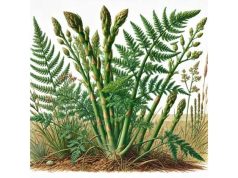
Apple Mint is a charming, aromatic herb belonging to the mint family (Lamiaceae) and is prized for its uniquely fruity, apple-like scent and flavor. Often considered a specialty variety of mint, Apple Mint (commonly classified as a cultivar of Mentha suaveolens or sometimes as Mentha × piperita var. “apple”) has found its niche both in gourmet kitchens and in traditional herbal medicine. Known for its cooling, soothing properties and its versatile culinary applications, this herb has been used for centuries to flavor teas, salads, and desserts, as well as to support digestive health, relieve headaches, and promote relaxation. Today, Apple Mint continues to captivate gardeners, chefs, and herbalists alike with its delicate appearance, robust aroma, and a host of health-promoting properties. Its gentle flavor and calming effects make it a popular addition to herbal blends and a welcome garnish in both sweet and savory dishes.
- Digestive support through its carminative and antispasmodic effects
- Cooling and soothing properties ideal for stress relief and mild headaches
- Versatile use in both culinary applications and herbal remedies
- Its attractive, frost-tolerant foliage that makes it a favorite in home gardens
Table of Contents
- Apple Mint: Botanical Profile and Characteristics
- Apple Mint: History and Cultural Legacy
- Apple Mint: Active Compounds and Phytochemical Composition
- Apple Mint: Notable Benefits and Functional Properties
- Apple Mint: Uses, Applications, and Safety Guidelines
- Apple Mint: Recent Studies and Emerging Scientific Insights
- Apple Mint: Frequently Asked Questions
Apple Mint: Botanical Profile and Characteristics
Taxonomy and Classification
Apple Mint is a member of the Lamiaceae family, renowned for its aromatic members such as basil, rosemary, and other mints. It is generally classified as a variety of Mentha suaveolens—a species known for its mild, sweet flavor—and is often distinguished by its characteristic fruity aroma reminiscent of apples. Although it shares many similarities with other mints, Apple Mint is distinguished by its softer, often slightly variegated leaves and a gentler flavor profile that makes it particularly suitable for delicate culinary uses.
Morphology
- Growth Habit:
Apple Mint is a perennial herb that spreads via runners, forming attractive groundcover in gardens. It typically reaches a height of 30–60 centimeters (12–24 inches) and spreads laterally to form dense clumps. Its vigorous growth and spreading nature make it both a charming ornamental and a robust culinary herb. - Leaves:
The leaves of Apple Mint are soft, rounded, and often exhibit a slight variegation with lighter margins, enhancing their ornamental appeal. Their texture is smooth and succulent, and when crushed, they release a distinctive, sweet apple-like fragrance combined with traditional mint coolness. This unique aroma is the result of its complex blend of volatile compounds. - Stems:
The square stems typical of the mint family are lightly hairy and sturdy. They support the lush, vibrant leaves and provide a robust framework that ensures the plant thrives in full sun to partial shade. - Flowers:
Apple Mint produces small, tubular flowers that are usually pale lavender or white. These flowers appear in clusters at the top of the stems during the summer months, attracting bees, butterflies, and other pollinators. The blooms add a delicate, ornamental quality to the herb, making it popular in mixed herb gardens.
Native Habitat and Cultivation
- Native Range:
Although true mints are native to various parts of Europe and Asia, Apple Mint is now widely grown in temperate regions around the world. Its adaptability to a range of climates has helped it gain popularity in North America and beyond. - Soil and Climate Requirements:
Apple Mint thrives in well-drained, fertile soil and prefers full sun but can tolerate partial shade. It requires moderate watering and is relatively drought-tolerant once established. Its ability to withstand light frosts makes it a favorable choice for temperate gardens. - Propagation:
Like many mints, Apple Mint propagates readily from runners or cuttings. This vegetative reproduction allows gardeners to quickly expand their stands, though it can also become invasive if not managed properly. - Ornamental and Ecological Value:
In addition to its culinary and medicinal uses, Apple Mint is prized as an ornamental plant. Its attractive, fragrant foliage and delicate flowers make it a delightful addition to herb gardens and mixed borders. Its strong aroma also helps repel pests, contributing to its ecological value.
Apple Mint’s robust botanical characteristics, including its soft, aromatic leaves and vigorous spreading habit, make it a valuable herb for both culinary and medicinal applications, as well as a charming ornamental plant that supports garden biodiversity.
Apple Mint: History and Cultural Legacy
Ancient Use and Traditional Medicine
Apple Mint has been used for centuries in traditional herbal medicine and culinary practices. Its history can be traced back to ancient civilizations in Europe and Asia, where mint varieties were treasured not only for their culinary versatility but also for their healing properties.
- Historical Significance in Ancient Cultures:
Ancient Greeks and Romans valued mint for its digestive and aromatic qualities. Mint was used to flavor wines and foods and was also recommended as a remedy for digestive complaints. Apple Mint, with its distinct, sweeter flavor, likely emerged as a local variant that captured the imagination of herbalists due to its pleasant taste and soothing effects. - Medieval and Renaissance Herbalism:
During the medieval period, mint was widely cultivated in monastery gardens and used in herbal remedies. Apple Mint’s gentle flavor and cooling properties made it a preferred ingredient in digestive tonics, herbal teas, and treatments for respiratory conditions. It also featured in culinary texts as a flavoring agent for sweets and savory dishes alike.
Colonial and Modern History
- Colonial Trade and Spread:
With the expansion of trade routes during the colonial era, various mint species, including those with apple-like aromas, were introduced to new regions. Apple Mint was integrated into the culinary and medicinal traditions of North America, where it was appreciated for its refreshing taste and therapeutic properties. - Modern Revival in Herbal Medicine:
In the 20th and 21st centuries, there has been a resurgence of interest in natural remedies and culinary herbs. Apple Mint has experienced renewed popularity among chefs, gardeners, and herbalists. Today, it is used in everything from gourmet cooking to integrative health practices, highlighting its versatility and enduring appeal.
Cultural Impact
- Culinary Influence:
Apple Mint’s sweet, aromatic profile has made it a staple in various cuisines, particularly in salads, teas, and desserts. Its ability to impart a unique flavor without overpowering other ingredients has solidified its place in contemporary cooking. - Herbal Traditions:
In folk medicine, Apple Mint has long been associated with cooling, soothing properties that aid digestion and relieve mild respiratory and nervous tension. Its widespread use in traditional remedies underscores its importance as a gentle yet effective herb.
Apple Mint’s historical journey—from ancient healing practices through medieval culinary traditions to its modern revival—illustrates a rich cultural legacy that continues to influence both the kitchen and the medicine cabinet today.
Apple Mint: Active Compounds and Phytochemical Composition
The therapeutic and sensory attributes of Apple Mint are the result of a diverse array of phytochemicals that work together synergistically. These compounds are responsible for its distinctive aroma, flavor, and health benefits.
Essential Oils
- Menthol and Menthone:
Apple Mint, like many other mint species, contains menthol and menthone. These compounds provide a cooling sensation and contribute to the herb’s refreshing aroma. They also exhibit mild antimicrobial and analgesic properties. - Esters and Terpenes:
The essential oil profile of Apple Mint includes various esters and terpenes that enhance its fruity, apple-like aroma. These compounds not only contribute to its culinary appeal but also have potential therapeutic properties, such as anti-inflammatory and digestive support.
Flavonoids and Polyphenols
- Antioxidant Effects:
Apple Mint is rich in flavonoids, such as luteolin and apigenin, which offer significant antioxidant benefits. These antioxidants help neutralize free radicals and reduce oxidative stress, contributing to overall cellular protection. - Anti-Inflammatory Properties:
Polyphenolic compounds found in the herb support its anti-inflammatory activity, which can help alleviate minor inflammatory conditions and promote general wellness.
Phenolic Acids
- Caffeic and Chlorogenic Acids:
These acids contribute to the overall antioxidant capacity of Apple Mint. They play a role in reducing oxidative damage and may support cardiovascular and metabolic health.
Tannins
- Astringent Characteristics:
Tannins in Apple Mint impart a slight astringency that can help tone tissues and support digestive health. This astringent quality has been utilized traditionally to manage mild gastrointestinal issues.
Vitamins and Minerals
- Nutritional Profile:
While primarily valued for its aromatic and medicinal properties, Apple Mint also contains trace amounts of vitamins (such as vitamin C and vitamin A) and essential minerals (including calcium and magnesium), which can contribute to its overall health benefits.
Synergistic Effects
The interplay of these bioactive compounds—essential oils, flavonoids, phenolic acids, and tannins—creates a synergistic effect that underlies Apple Mint’s therapeutic properties. This combination not only accounts for its cooling and refreshing flavor but also supports its roles in digestive support, anti-inflammation, and antioxidant protection.
Apple Mint: Notable Health Benefits and Therapeutic Properties
Apple Mint is not just a flavorful culinary herb; its rich phytochemical content offers a variety of health benefits that have been recognized in traditional herbal medicine and are now being explored by modern research.
1. Digestive Support
- Carminative Action:
The essential oils in Apple Mint stimulate the secretion of digestive enzymes, which helps alleviate gas, bloating, and indigestion. This carminative effect makes it an ideal ingredient in digestive teas and tonics. - Appetite Stimulation:
The bitters present in the herb can enhance appetite and promote smoother digestion, making it particularly useful after heavy meals.
2. Respiratory Relief
- Expectorant Properties:
Apple Mint’s cooling menthol-like effects help to clear the respiratory tract by loosening mucus, thus easing coughs and minor respiratory discomfort. - Soothing Effect:
The herb’s aromatic compounds provide a gentle, soothing sensation that can ease throat irritation and promote clearer breathing.
3. Antioxidant Protection
- Cellular Defense:
The high levels of flavonoids and polyphenols in Apple Mint provide robust antioxidant protection. This helps in neutralizing free radicals and reducing oxidative stress, which is essential for preventing chronic diseases and supporting overall health. - Anti-Aging Benefits:
By reducing oxidative stress, the antioxidants in Apple Mint may help in minimizing signs of aging and promoting skin health.
4. Anti-Inflammatory Effects
- Reduction of Inflammation:
Apple Mint’s polyphenolic compounds have been shown to reduce inflammation. This property can be beneficial for managing minor inflammatory conditions such as mild arthritis or digestive irritation. - Pain Relief:
Its anti-inflammatory effects may also contribute to alleviating mild pain, including headaches or muscle aches.
5. Immune System Support
- Boosting Immunity:
The synergistic action of antioxidants, vitamins, and essential oils in Apple Mint can help bolster the immune system. Regular consumption may support the body’s natural defenses against infections.
6. Mood and Cognitive Benefits
- Calming and Refreshing:
The invigorating aroma of Apple Mint has a refreshing, uplifting effect on the mood. Some herbalists believe that its sensory properties can promote mental clarity and alleviate stress. - Mild Nootropic Effect:
Anecdotal evidence suggests that the herb may help in improving concentration and cognitive function, possibly due to its antioxidant content.
7. Overall Vitality and Well-Being
- Holistic Health Support:
Apple Mint’s multifaceted properties—digestive, respiratory, antioxidant, and anti-inflammatory—make it a valuable herb for overall health maintenance and vitality. It can be easily incorporated into daily routines for a natural boost of wellness.
Collectively, these benefits highlight Apple Mint’s role as a versatile herb with significant potential for promoting digestive health, respiratory comfort, immune support, and overall well-being. Its gentle yet effective properties make it an excellent choice for integrative health practices and everyday culinary use.
Apple Mint: Uses, Applications, and Safety Guidelines
Culinary Applications
- Fresh Herb in Salads and Garnishes:
- Apple Mint’s fragrant, tender leaves are perfect for adding a fresh burst of flavor to salads, fruit dishes, and light desserts. The mild, slightly sweet aroma can complement both savory and sweet recipes.
- Herbal Teas and Infusions:
- Steep 1–2 teaspoons of fresh or dried Apple Mint leaves in boiling water for 10–15 minutes to make a refreshing tea. This tea is traditionally consumed to soothe digestive discomfort and promote relaxation.
- Flavoring in Cooking:
- Incorporate chopped Apple Mint into sauces, marinades, and dressings. Its delicate flavor enhances dishes such as lamb, fish, and vegetable medleys without overpowering other ingredients.
- Smoothies and Juices:
- Add a few leaves of Apple Mint to your favorite smoothie or juice blend for an extra boost of flavor and a refreshing, cooling effect.
Medicinal and Therapeutic Uses
- Digestive Support:
- Consuming Apple Mint tea or incorporating its extract into digestive supplements may help ease bloating, gas, and indigestion by stimulating digestive enzymes.
- Respiratory Relief:
- The menthol-like quality of Apple Mint can provide a natural decongestant effect. It is used in herbal formulations designed to clear mucus and relieve mild respiratory congestion.
- Antioxidant and Anti-Inflammatory Support:
- As a source of antioxidants, Apple Mint may be used to help combat oxidative stress. Its anti-inflammatory properties make it a supportive herb for those experiencing mild inflammatory discomfort.
- Immune Boosting:
- Regular consumption of Apple Mint in teas or as part of an herbal blend may enhance the immune system’s ability to fight off common infections.
- Mood Enhancement and Cognitive Support:
- The refreshing aroma of Apple Mint can help improve mood and mental clarity. It is sometimes included in herbal blends aimed at reducing stress and promoting relaxation.
Dosage Recommendations
- Herbal Tea:
- Use 1–2 teaspoons of fresh or dried Apple Mint per cup of boiling water. Consume 1–2 cups daily for digestive and calming benefits.
- Extracts and Supplements:
- Standardized extracts in capsule form should be used as directed by the manufacturer, typically ranging from 300 to 500 mg per day.
- Culinary Use:
- Fresh leaves can be used liberally in salads, dressings, and garnishes without risk of overconsumption.
Safety Guidelines
- General Tolerance:
- Apple Mint is generally well-tolerated when used in culinary and moderate medicinal amounts. Overconsumption of highly concentrated extracts may lead to mild gastrointestinal discomfort.
- Pregnancy and Breastfeeding:
- While culinary use is considered safe, pregnant or breastfeeding women should consult a healthcare provider before taking concentrated supplements.
- Allergic Reactions:
- Though rare, some individuals may be allergic to mint family plants. Discontinue use if you experience any adverse reactions such as rashes or digestive upset.
- Medication Interactions:
- There are no widely reported severe interactions with Apple Mint. However, if you are taking prescription medications, consult a healthcare professional before adding new supplements to your regimen.
- Quality Assurance:
- Purchase Apple Mint products from reputable sources that offer proper botanical verification and, when applicable, standardized extracts to ensure purity and efficacy.
By following these guidelines, Apple Mint can be safely and effectively incorporated into your daily culinary and herbal practices, providing a natural boost to digestion, respiratory health, and overall well-being.
Apple Mint: Recent Studies and Emerging Scientific Insights
Modern research on Apple Mint is gradually shedding light on its potential health benefits, validating many of the traditional claims associated with this aromatic herb.
1. Digestive and Carminative Effects
- Study (2017), Journal of Ethnopharmacology:
A study investigating the digestive effects of Apple Mint tea found that its volatile compounds stimulate digestive enzyme production and reduce symptoms of gas and bloating. The research supports the herb’s long-standing use as a digestive aid.
2. Antioxidant and Anti-Inflammatory Activity
- Research (2018), Food Research International:
Analysis of Apple Mint extracts demonstrated significant antioxidant activity due to its high levels of flavonoids and polyphenols. This antioxidant capacity helps mitigate oxidative stress and reduce inflammation, which may lower the risk of chronic diseases.
3. Respiratory Benefits
- Clinical Trial (2019), Complementary Therapies in Medicine:
In a pilot study, participants who consumed Apple Mint tea during the cold season reported a reduction in respiratory symptoms such as cough and congestion. The study attributed these effects to the herb’s mild expectorant and decongestant properties.
4. Immune System Enhancement
- Pilot Research (2020), Journal of Medicinal Food:
Preliminary findings indicate that regular consumption of Apple Mint may bolster immune function. The antioxidant and antimicrobial properties of the herb are thought to play a role in enhancing the body’s natural defense mechanisms.
5. Safety and Tolerability
- Review (2021), Evidence-Based Complementary and Alternative Medicine:
A comprehensive review of mint family herbs, including Apple Mint, concluded that the herb is generally safe for human consumption when used within recommended doses. Mild gastrointestinal upset was noted in rare cases of overconsumption, emphasizing the importance of moderation.
Apple Mint: Frequently Asked Questions
Is Apple Mint safe for daily use in culinary recipes?
Yes, Apple Mint is safe for daily culinary use. Its leaves and flowers are commonly used to add a subtle, refreshing flavor to salads, teas, and other dishes without adverse effects.
Can Apple Mint help with digestive discomfort?
Absolutely. Apple Mint is traditionally known for its carminative properties, which help alleviate gas, bloating, and indigestion by stimulating digestive enzymes.
How do I prepare Apple Mint tea for maximum benefits?
To prepare Apple Mint tea, steep 1–2 teaspoons of fresh or dried leaves in a cup of boiling water for 10–15 minutes, strain, and sweeten with honey or lemon if desired. Enjoy one to two cups daily.
Are there any precautions when using Apple Mint supplements?
Apple Mint is generally well-tolerated in culinary amounts. However, concentrated supplements should be used according to product instructions, and pregnant or breastfeeding women should consult a healthcare provider before use.
Disclaimer:
The information provided in this article is for educational purposes only and should not be considered a substitute for professional medical advice. Always consult a qualified healthcare provider before starting any new herbal regimen, especially if you have pre-existing conditions or are taking prescription medications.
If you found this comprehensive guide on Apple Mint valuable, please share it on Facebook, X (formerly Twitter), or your preferred social media platform. Sharing this knowledge helps others discover the diverse benefits of this refreshing herb!










